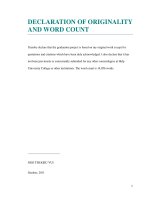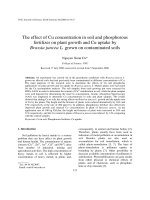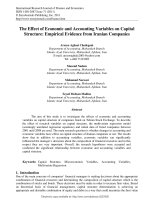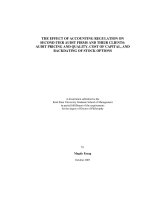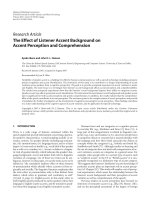the effect of monetary incentive on effort and task performance a study of vietnamese company
Bạn đang xem bản rút gọn của tài liệu. Xem và tải ngay bản đầy đủ của tài liệu tại đây (678.52 KB, 89 trang )
1
DECLARATION OF ORIGINALITY
AND WORD COUNT
I hereby declare that the graduation project is based on my original work except for
quotations and citations which have been duly acknowledged. I also declare that it has
not been previously or concurrently submitted for any other course/degree at Help
University College or other institutions. The word count is 14,056 words.
______________________
NGO THI KIEU VUI
October, 2011
2
ACKNOWLEDGEMENT
First at all, I would like to express my sincere thanks to my project supervisor, Dr. Le
Van Lien, International School, Vietnam National University Hanoi for guidance and
encouragement in carrying out this project work.
Great deals appreciation goes to Ms. Sumathi, Help University College, who initiated
and gives me much instruction and support about the dissertation.
My sincere thanks to the collaboration of Mr. Nguyen Xuan Luat_ Director of
VIETCOMBANK, and Ms. Phung Nguyen Hai Yen_ Chief Accountant of
VIETCOMBANK, have spent time to help me in my interview.
I also wish to express my gratitude to Vietnamese teachers at International School and
the Malay teachers at Help University College who taught and helped me during the
study process at the International School. Thanks to my foreign friends especially those
who work with me during my study time. Not forget, great appreciation go to teachers
and friends who have worked closely with me throughout my five of study at the
University.
Finally yet important, I wish to avail myself of this opportunity, express a sense of
gratitude and love to my beloved parents for their support, strength and encouragements.
NGO THI KIEU VUI
3
THE EFFECT OF MONETARY INCENTIVE ON EFFORT AND TASK
PERFORMANCE: A STUDY OF VIETNAMESE COMPANY
By
NGO THI KIEU VUI
October 2011
Supervisor: Dr. Le Van Lien
ABSTRACT
In many Vietnamese companies, incentive systems are designed to motivate employees
at work and attract new talented candidates. Monetary incentives are considered as the
most powerful motivational tool in such systems. The companies originally use
monetary incentives for the purpose of encouraging their employees to perform in the
most effective way. However, in practice, the effectiveness of using monetary incentive
to encourage them is still controversial among the researchers. In the accounting field,
managers and accountants play important roles in preparing a complete financial
statement. How to encourage them to make the true and fair financial statements is very
important to various parties in a company. The purpose of this research is to find out the
real effect of monetary incentive in the workplace, especially its effectiveness on
motivating managers and accountants in providing the true and fair financial statement
and performing other tasks in the company.
4
TABLE OF CONTENTS
DECLARATION OF ORIGINALITY AND WORD COUNT 1
ACKNOWLEDGEMENT 2
ABSTRACT 3
TABLE OF CONTENTS 4
LIST OF FIGURES 7
LIST OF ABBREVIATIONS 8
1. INTRODUCTION 9
1.1. Background of study 9
1.1.1 Monetary incentive in the world 9
1.1.2. Monetary incentive in Vietnam 10
1.1.3. Accounting scandal involved in monetary incentive 11
1.2. Scope of research 12
1.3. Problem statements 13
1.4. Hypotheses 14
1.5. Organization of research 15
2. LITERATURE REVIEW 17
2.1. Issues related to monetary incentives 17
2.1.1. Motivation 17
2.1.2. Monetary incentive 19
2.1.3. Arguments for monetary incentives 21
2.1.4. Arguments against monetary incentives 22
5
2.2. Review of accounting theories related with monetary incentives 23
2.2.1 Adams’ Equity Theory 23
2.2.2 Bonus schemes 26
2.2.2.1 Accounting-based bonus plans 27
2.2.2.2 Market-based bonus schemes 30
2.2.3 Agency Theory 31
2.2.4 Possitive Accounting Theory 34
2.2.4.1 Three key hypotheses of Positive Accounting Theory 35
2.2.4.2 Opportunistic perspective 36
3. RESEARCH METHODOLOGY 39
3.1. Research objective 39
3.2. Data source 40
3.2.1. Secondary data 40
3.2.2. Primary data 41
3.3. Research method 41
3.4. Research tool 42
3.4.1. Questionnaire 42
3.4.2. Personal interview 43
3.5. Data collection 43
3.6. Sampling 44
3.6.1. Sample population 44
3.6.2. Sample frame 44
3.6.3. Sample size 44
6
3.6.4. Sample techniques 44
3.7. Limitations 44
4. FINDINGS AND ANALYSIS 46
4.1. Test for Hypotheses 48
4.1.1 Hypothesis 1 48
4.1.2. Hypothesis 2 50
4.1.3. Hypothesis 3 51
4.2. Overall discussion from questionaire survey 53
4.2.1 Purpose and motivation at work 53
4.2.2 Imbalance between monetary incentive and input 56
4.2.3 Opportunism in work 59
4.3. Overall discussion from managers and accountants interviews 61
5. CONCLUSION 65
REFERENCES 68
APPENDIX A: QUESTIONNAIRE 78
APPENDIX B: STATISTICAL TEST 81
7
LIST OF FIGURES
Table 4.1 Classification of the Respondents from Different Sector 46
Table 4.2 Classification of the Respondents from Different Gender 46
Table 4.3 Classification of the Respondents of Different Age Group 47
Table 4.4 Respondents’ purpose and motivation at work 49
Table 4.5 Imbalance between monetary incentive and input 51
Table 4.6 Opportunism in work 52
Figure 4.1 Classification of the Respondents from the Length of Employment 47
8
LIST OF ABBREVIATIONS
EMH Efficient Market Hypothesis
FD Financial Director
GAAP Generally Accepted Accounting Principles
IAS International Accounting Standard
NPV Net present value
PAT Positive Accounting Theory
R&D Research and development
VAS Vietnamese Accounting Standard
9
1. INTRODUCTION
1.1. Background of study
1.1.1. Monetary incentive in the world
Monetary incentives have been known as a motivation tool and have been used in many
companies in the world many years ago. The most popular forms of monetary incentive
are bonus and share options. Since 1929, Bethlehem Steel was the second-largest steel
manufacturer in the US. Eugene G. Grace, President of Bethlehem Steel, was rewarded a
$1.6 million bonus. He became the first million-dollar man at a public company
(Business Week, 1999). In the history, the success of many large companies usually
records a large amount of monetary incentive to be paid for the board of management.
This result has been shown in many surveys conducted by Business Week Magazines,
Financial Director (FD) Magazines.
In 1997 Business Week’s annual executive pay survey, Coca-Cola provided Roberto
Goizueta, CEO of Coca-Cola, a total of $111.8 million which consisting of annual
salary, bonuses, and long-term compensation. This was also one of the most well-paid
monetary incentive packages in the history of public companies. However, Coke’
shareholders were very happy with such incentive package. It could be said that the
whole life of Goizueta devoted to Coca-cola during his 16 years reign, he has made great
contributions to the company. Coke’s stock increased at an amazing 3,800 per cent
(Roger Martin). In the same year, top executives of nearly half of the 200 largest
companies were awarded a large number of options that worth at least $10 million. In
10
addition, according to 2005 FD salary survey, Kevin Hayes, FD of Man Group_ a world
leading alternative investment management business, ranked no. 1 in FTSE-100 FD pay
league with a total pay of £2,359,000 including £310,000 salary, £2,000,000 bonus and
£49,000 others (Financial Director, 2005). Hayes’ bonus was even much higher than his
basic salary. In these cases, the success of these companies was based on the fact that
monetary incentive has played an important role in encouraging the board of
management on performance.
1.1.2. Monetary incentive in Vietnam
Nowadays, with the widespread use of monetary incentive, almost all Vietnamese
companies have set up bonus and welfare funds to reward their employees while the
Vietnam law on Enterprises (2005) does not oblige the companies to set up such funds.
Many companies have used monetary incentives as a good starting point to encourage
their employees’ performance and they have seen monetary incentive as a good
motivational tool to improve their employees’ behavior. Within companies, managers
and accountants are often the most important people in performing financial statements.
Many companies have rewarded them based on the result of the financial reports. That
means if there are high reported earnings; they could be rewarded high bonuses or more
number of share options. The use of monetary incentive is expected to increase their
effort in performing the true and fair financial statement. However, monetary incentive
might motivate them in choosing accounting methods, which bring the best interest for
them, but not for the company.
11
In Vietnam, there are not many surveys conducted as what has been done by Business
Week and Financial Director. In addition, it is very hard to find sufficient information
which involves managers’ and accountants’ monetary incentive because there are only a
few companies voluntarily declared and the Vietnamese Accounting Standard Board
(VASB) does not require the company to disclose such amounts (Vietnamese
Accounting Standard). Only one thing that can be easily recognized is that managers are
often rewarded more than the direct labor of many workers in many companies. This can
be explained by the fact that managers often have to work harder, have to have more
achievements, more influential, more dedication for the company. Therefore, it is very
difficult to evaluate their’ performance, and the link between monetary incentive and
their performance.
1.1.3. Accounting scandal involved in monetary incentive
In history, there were many accounting scandals in the world. This study will
mention a typical scandal involved in monetary incentives in the accounting history.
That is the case of Nortel Networks Corporation. Since 1895, Nortel Networks
Corporation was a Canadian multinational telecommunications equipment manufacturer.
Then, it has rapidly grown into a global leader in delivering communications capability
(Corporate website). However, it was involved in the worst telecom meltdown in the
history when it announced a loss of $2.2 billion for the last quarter of 2005. On 2 July
2007, a Wall Street Journal reported that Nortel manipulated its books by misusing
accrued liabilities to boost profit earnings (Wojtek Dabrowski, 2008). Many of Nortel’s
executives have been charged by U.S regulators for engaging in accounting fraud. They
12
manipulated Nortel’s books to meet Wall Street’s expectations, and pay themselves high
level of bonuses. “Nortel's earnings management fraud could not have happened
without their efforts. These defendants all received significant compensation while they
were falsifying Nortel's financial results”_ Christopher Conte said_ an Associate
Director of the Commission’s Division of Enforcement (U.S Securities and Exchange
Commission, 2007). It was believed that the cause of this scandal was Nortel’s board
put a too powerful monetary incentive package for its leaders into place. If Nortel
reached break even point for the first quarter, the management team would be rewarded
US$13.6 million and US$30 million for three consequence quarters. This drove senior
management to intentionally under-report income in 2002 in order to ensure to break
even in 2003. Due to the intention of management, 2003 was a break-even year and
Nortel’ CEO and CFO were rewarded a huge amount of bonuses in cash and stock.
Frank Dunn, one-time CEO, sacked $2.15 million. CFO Douglas Beatty got $831,000.
In 2003, Nortel had to pay US$10 million for managers’ bonuses. It is clear that
monetary incentive had motivated management in manipulating accounting information.
Therefore, Nortel had not used monetary instruments effectively in encouraging
managers to product the true and fair accounting information.
1.2. Scope of research
This study focuses on the effectiveness of using monetary incentives in motivating effort
and task performance. However, this thesis on the effect of monetary incentives on effort
and task performance of every worker seems more like a thesis for social science major.
This thesis must satisfy all the requirements for the degree of Bachelor of Accounting. In
13
addition, in accounting field, managers and accountants can be considered as the most
important people who influence the financial reports. Therefore, the scope of research
will be limited by only researching on effort and task performance of managers and
accountants in Vietnamese companies. In addition, there is a close relationship among
them because accountants are people who directly prepare financial statements;
managers are people who take charge of choosing accounting methods for their
company. It is very hard to separate the role of managers and accountants in performing
financial statements. This study will consider managers and accountants to be a unique
entity and these names are interchangeable in the study.
1.3. Problem statements
There are many problems involved in utilizing monetary incentives to motivate
employees in Vietnamese companies. The following research questions are tried to
address the effect of monetary incentive on effort and task performance:
Do all Vietnamese companies have reward funds to motivate accountants and
managers?
Which circumstances can the companies use money to motivate managers
and accountants on effort and task performance?
What happens if monetary incentives are not parallel with managers and
accountants’ effort?
What are the types of monetary incentive that can motivate managers and
accountants the most?
14
Should monetary incentives always be used to motivate employees on effort
and task performance in today’s working environment in Vietnam?
1.4. Hypotheses
There are three hypotheses to be established and tested by chi-square test. H1 represents
the alternatives of hypothesis and H0 represents the null hypothesis. The hypothesis will
be tested with the significant level α = 0.05.
Hypothesis 1
H1: The purpose of work of managers and accountants is mainly due to money and they
are motivated on performance by monetary incentive.
H0: The purpose of work of managers and accountants is not mainly due to money and
they are not motivated on performance by monetary incentive.
Hypothesis 2
H1: If the monetary incentive is imbalance with managers’ and accountants’ input, they
usually do not perform their tasks well.
H0: If the monetary incentive is imbalance with managers’ and accountants’ input, they
still perform their tasks well.
Hypothesis 3
H1: Regardless of how much monetary incentive, when there is an opportunity,
managers and accountants will act opportunistically.
15
H0: Regardless of how much monetary incentive, when there is an opportunity,
managers and accountants will not act opportunistically.
1.5. Organization research
The studies are into five chapters with different objectives as following:
Chapter I: Introduction
In this chapter, the study provides a general picture about the relating topic. In
particular, it gives introductions about monetary incentives, main objectives of the study
and problems involved in the application of monetary incentive in Vietnamese
companies.
Chapter II: Literature review
This chapter concentrates on explaining all concepts and theories related to the topic.
Thus, this chapter focuses on explaining all the issues and the main theory relates to
monetary incentive.
Chapter III: Research methodology
This chapter describes all techniques and strategy used to conduct the research such as
data source, research tools, and data collection. This chapter also mentions to some
difficulties when the researcher conducts the study.
Chapter IV: Findings and analysis
This chapter shows all findings from the collected data after conducting survey related to
topic. And then, the chapter mainly focuses on analyzing all the collected data. The
collected information is very necessary to investigate the effect of monetary incentive on
task and effort performance of managers and accountants.
16
Chapter V: Conclusion
This is the final chapter in the study. The main duty of this chapter is to sum up all the
results from the study.
17
2. LITERATURE REVIEW
2.1. Issues related to monetary incentive
2.1.1. Motivation
Thousands of years ago, when the concept of “motivation” was still unknown, people
realized the importance of influencing workers to accomplish task performances. Many
years later, this was the premise of the appearance of the term “motivation” and then it
has rapidly become one of the most common concepts in everyday language.
Nowadays, it is a concerning issue of almost all companies and a difficult subject in the
workplace. Although it is very difficult to define this concept rigorously, there are still
various definitions on this concept.
Motivation can be referred to as “the act of stimulating someone or oneself to get a
desired course of action to push the right button to get a desired reaction, a compliment,
dollar raise, a smile, a promise of a rise, a new typewriter, a preferred location or a new
desk” (Michael L. Jucius); “the psychological process that gives behavior purpose and
direction” (Kneitner, 1995); “give reason incentive, enthusiasm, or interest that causes
a specific action or certain behavior” (Wenday Pan, 2008); or “a set of forces that
directs an individual to the behavior that results in better job performance” (Ashim
Gupta, 2011). Two main kinds of motivation are intrinsic and extrinsic. Intrinsic
motivation (non-financial incentive) comes from within the individual, not from any
outside pressure, such as public recognition or feelings of achievement. It is driven by
enjoyment and pleasures of completing a task. Adversely, extrinsic motivation (financial
18
incentive) occurs when external factors attract employees to work, for example,
monetary incentives or punishment.
Motivation brings advantages to both the company and employees. If an employee is
highly motivated, motivation will be converted to “probably work harder, produce a
higher quality of work and be less liable to take time off”. In addition, it helps to “avoid
clashes and non-cooperation and brings harmony, unity and co-operative outlook
among employees” (Gauray Akrani, 2010). As a result, the company can increase the
efficiency and productivity of employees which lead to increase profitability. For the
employees, they can get various benefits, such as monetary and non-monetary facilities
in exchange for their efforts. In 1955, Elton Mayo had conducted the Hawthorne
Studies from 1924 to 1932 (James R. Lindner, 1998). The results of these studies help
us to understand what motivated people at work; and how they were motivated. In
almost all companies, motivational techniques are very useful to leaders, employers and
other managers. Management can consider motivation as a key role in leadership
success.
According to Walter, motivation is also the most important factor of performance
(Walter Jack Duncan, 1998, p438). Many evidences show that enhancing motivation
will lead to promote performance (McCullage, 2005; Wilson, 2005). Moreover,
motivation is the most fundamental factor for workers to stick with the job and do a
better job. In the human resource management, motivating employees to work on high
effort is one of the most important issues. In the accounting field, motivating managers
and accountants in choosing accounting policies that bring the best interest for the whole
company is the most important one. When the issue is motivation, companies need to
19
motivate managers and accountants on higher performance. For owners, they should be
especially aware of the importance of motivation because only if they understand the
importance of it, then can they implement incentive policy to motivate their employees
at work. In addition, managers also need to think about what motivates them to work
because most people have to work with high pressure throughout their life.
2.1.2. Monetary incentive
An incentive in anything can be referred to as a motivation for doing a particular course
of action. It makes managers as well as other employees desirous to do better, try harder
and expend more energy. Vaida (2003) stated that “incentives are used to reward
outstanding performance and to sustain efficiency in work processes”. In the companies,
they usually offer incentive systems as an important part of the companies’ motivation.
These systems are usually used as the way to reward staff. In many cases, incentive
systems are also used for the purpose of correcting and preventing the employees’
mistakes in term of penalties, fines and other punishments. However, the systems can
encourage or discourage their employees up to their ability in designing these systems.
A good incentive system can encourage employees to work harder, produce more
efficiency and foster loyalty to the company.
Monetary incentive is a type of incentive and used as a motivation tool. The companies
offer monetary incentive to all categories of workers in terms of rewarding money in
exchange for their desired performance. In general, monetary incentive is paid in
addition to basic wages or salary. It may be further divided into two categories:
individual monetary incentive and group monetary incentive. Individual monetary
20
incentive means that individuals are paid “based solely on the performance of the
individual employee” (Judith, 2001). F.W. Taylor suggested a good example of the
individual monetary incentive which is different incentive wage plans. Different
employees have different ability in production. Therefore, they are paid different
incentive wages as per their production efficiency. As for managers and accountants,
they hold important positions in a company. Their responsibility is often higher than
other employees. They also have to work on higher effort than others. This also means
the company should pay them different monetary incentives than others. Moreover, if
managers want to be paid more monetary incentive, they need to work more efficiently
and productively than others. With group monetary incentives, the monetary incentive is
given to a group of employees or to all employees in the company. Some typical
examples of the group monetary incentives are bonus payment, profit sharing, pension
funds. Rewarding managers as a group will motivate them to cooperate with other
employees to accomplish the company’s goals. Furthermore, this also motivates
managers to act in the best interest of the company. For the company as a whole, group
monetary incentive brings many benefits. However, because performance is evaluated
over the group’s performance, the owners will have less control over each manager’s
performance. In many cases, managers may work less effectively and productively than
they are paid individual monetary incentives (Blinder, 1990; McCoy, 1992).
Bonus is a typical example of monetary incentive. It can be defined as “compensation
for employees for work performed, they are paid in addition to salary or wages” (Jean
Murray, 2011). Within companies, owners consider bonus as the most effective
rewarding tool to strike the balance between the effort that managers put into work and
21
what they deserve from the company. In addition to rewarding workers for their effort in
doing a good job, bonus plays an important role in encouraging them and creating
incentives for them to provide the true and fair view in the financial statements.
However, with managers as well as other employees, they have to pay tax for bonuses.
For companies, they will benefit from tax payments when these amounts are treated as
an expense of doing business. So, the companies tend to reduce salaries and increase
bonuses to promote performance. Bonus is often similar in almost all companies because
they are used to measure how well a person is doing with respect to the owners’
expectation and how well a company is doing with respect to its expectation.
2.1.3. Arguments for monetary incentives
In the 21
st
century society, many people believe that money can help to resolve most
problems and purchase many things depending on the sum of money in possession.
Therefore, may people believe that monetary incentive can affect their behavior. In the
company, monetary incentive is the simplest and easiest technique to motivate workers.
Proponents argue that monetary incentive also brings many benefits when it affects
managers’ behaviors and provides a strong incentive for managers to attain the
company’s goal. Numerous studies have demonstrated that monetary incentive is a
useful technique to increase motivation and thus performance (Guzzo, Jette, & Katzell,
1985; Locke, Feren, McCaleb, Shaw & Denny, 1980). Each person has different
motivation for working and especially, no one works for free. Some people work for
love, fun, personal fulfillment, or fill up their free time with activity. Whatever any
22
personal reason that may be, almost everyone work for money. “The invisible hand” of
Adam Smith described the idea that people act on behalf of their own self-interests to
promote the public good (Peter Mork, 2004). That also means they work to serve their
self interest and are presumably motivated by money. Basic needs motivate them to
works for basic salary and monetary incentive might motivate them on better effort and
task performance. Smith showed that highly rewarding economic activities will affect
directly on one’s own self-interest and also maximize the economic well-being of
society. Smith believed that monetary incentive will bring several benefits to the
company when it motivates employees on higher level of performance. Thus, monetary
incentive is a good motivating tool in business.
2.1.4. Arguments against monetary incentives
In purpose, monetary incentives have been used to reward employees for desired
behavior and good performance. However, monetary incentives do not always achieve
the positive effect in a business. In some cases, they create some problems. There are
many arguments against the use of monetary incentive at work. In the article “Why
Incentive Plans Cannot Work” in 1993, Alfie Kohn argued that “rewards succeed at
securing one thing only: temporary compliance”. He indicated that at least two dozen
studies showed a complete opposite result with the purpose of using monetary incentive.
Monetary incentives may encourage employees to perform in a particular way to achieve
monetary reward but do not encourage them to do the right things. As a consequence of
this issue, monetary incentives may drive employees to be involved in unethical actions.
For example, in order to increase bonuses, an accountant intentionally falsified data
23
numbers to increase reported profits. Furthermore, many researchers such as Bahrick
(1954); Deci (1971); McGraw (1978); Gneezy and Rustichini (2000); Heyman and
Ariely (2004) also argued that monetary incentive leads to poorer performance. Cynthia
Hartman (2011) suggested that “non-monetary incentives are proving themselves as
much more effective tools in the workplace”. To improve work environments, non-
monetary incentives, such as flexible work schedules, pleasant work environment, will
be better to keep employees staying with the company in the future.
2.2. Review of accounting theories related to monetary incentive
Each group of person is motivated by different things. By reviewing the accounting
theories, they will help to understand what motivates accountants and managers to
generate higher energy in work and why they involve in actions that go against the
company’s best interest.
.
2.2.1. Adams’ Equity Theory
John Stacey Adams developed Adams’ Equity Theory_ job motivation theory_ in 1962
(Matt, 2009). “Adams’ Equity Theory calls for a fair balance to be truck between an
employee’s inputs (hard work, skill level, enthusiasm, and so on) and an employee’s
outputs (salary, benefits, intangibles such as recognition, and so on)” (“Adam’s Equity
Theory”, 1996). The theory explains how managers as well as other employees judge
the fairness of rewards with their effort put into work (McShane et al. 2000, 79.). Many
24
researchers evaluate this as one of the best theories that explain the necessity of balance
between input and output in motivating task performance.
Adam’s Equity Theory is considered as one type of the justice theories. The equity is
calculated based on the ratio of outputs over inputs. Adams suggests that in order to
achieve equity, work effort must be equal to work reward, or the equity ratio of one’s is
equal to others as the following equation:
)(
)(
)(
)(
OtherOutcomes
OtherInputs
IndividualOutcomes
IndividualInputs
Inputs are everything or all investments that a person puts into work. Typical examples
of inputs are effort, ability, hard work, flexibility, loyalty and so on. Outputs are what a
person takes out in return and equal reward minus cost. They can be financial rewards
such as monetary incentive, and non-financial rewards such as recognition, growth. In
order to receive an outcome such as bonuses and share options, the employee has to first
put investments into work such as time and effort. Adam believes that if outcomes are
less than inputs, workers will seek equilibrium in the form of reducing effort, requiring a
pay rise. In the case of over-rewards, employees may fell compelled to work more
effectively and productively. In such two cases, employees will become de-motivated.
Only if workers are rewarded equally to their contributions, they will be motivated the
most. Moreover, workers usually tend to make comparisons. They compare their
outcomes over inputs with others. If they feel that their receipts are equal to what others
receives for same inputs, they believe that the treatment is equitable and adversely, they
will transform to higher effort on task performance. Therefore, the study of Adam
showed that the equity or the balance between input and output is very necessary to
25
motivate workers in the workplace. If a worker feels that he/she is treated unequally,
he/she may be de-motivated.
Going along with the study of Adam about the balance between input and output, there
are also many researchers who conducted similar studies such as Vroom’s Expectancy
Theory (1964), Skinner’s reinforcement theory. In 1964, Vroom’s Expectancy Theory
was developed by Victor Vroom of Yale School of Management. The theory assumes
that people will make decisions among various choices based on “their perceptions
[expectancies] of the degree to which a given behavior will lead to desire outcomes”
(Isaac Ramoloko Mathibe, 2008). According to Vroom, individuals’ performance
depends on individual factor such as one’s skill, knowledge, experience and ability.
There is a positive correlation between performance and reward. If good performance is
rewarded, reward will satisfy workers on their effort and then drive performance. Next,
Reinforcement Theory of motivation was developed by BF Skinner and his associates. It
states that individual’s behavior causes consequences. The theory concentrates on “what
happens to an individual when he takes some action”. The reinforcement tools will help
to control the behavior of a person. For example, Positive Reinforcement is rewarding
the individual when he/she shows positive consequences and desired behavior. Negative
Reinforcement is the result of withholding an undesirable behavioral consequence. If
employers realized that their employees behave in the desired manner, employers will
stop criticizing or punishing them. In short, the balance between input and outcome is
very important in motivating effort and task performance.



